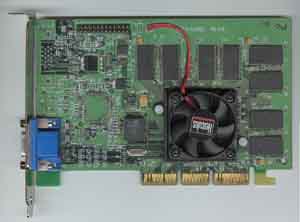The Card
The Hercules Dynamite TNT2 is built upon a somewhat sloppily laid out reference design PCB, the same one used on the Dynamite TNT2 Ultra. AnandTech's review sample was a 16MB model, featuring 6ns Hyundai SDRAM and retails for $149.99. A 32MB model is available for $199.99 with an optional software DVD player for $5 extra with either card. Neither TV-out nor an LCD-out is available on the standard Hercules Dynamite TNT2.
The Dynamite TNT2 is based on the "standard" version of the TNT2 chipset, which according to NVIDIA, indicates that the core clock speed and the memory clock speed should be no less than 125MHz and 150MHz respectively. However, NVIDIA has left the exact clock speeds up to the manufacturers and many have chosen to ship at higher than these recommended clock speeds.
In the case of the Hercules Dynamite TNT2, that means a factory setting of 145/170 MHz, which is the highest standard TNT2 we've seen to date. In fact, it's virtually "Ultra" TNT2 speed as NVIDIA suggests the Ultra should operate at 150/183 MHz. What we found in our July 1999 TNT2 Roundup is that all TNT2 boards would overclock to at least 150/170, but the Dynamite TNT2 was still a step ahead of the competition. As a standard TNT2, it overclocked all the way to 190/190, exceeding the maximum speed of all other cards, including Ultra TNT2 based products, except the Dynamite TNT2 Ultra. As always with overclocking, the results will vary from card to card, but with the Hercules, you're guaranteed at least 145/170 operation.
Hercules secret isn't anything magical - just careful construction and testing. The big thing that they did was apply thermal compound properly - the thinnest layer possible, while still covering the whole chip. It seems simple, but it's something other manufacturers continue to overlook. It has paid off for Hercules as we found in our heat tests in the July 1999 TNT2 Roundup where the Dynamite TNT2 was the coolest running card available.
The memory is organized as eight 2MB chips, all on the front of the board. At 6ns, the Hyundai SDRAM is faster than that of other standard TNT2 cards and certainly helps in attaining such high speeds. The exact manufacturer of the memory may vary as the supply of Hyundai 6ns fluctuates, but Hercules should continue to use 6ns memory.
The 2D image quality of the Dynamite TNT2 is fine at resolutions up to 1280 x 1024, unfortunately at 1600 x 1200 the image quality takes a noticeable dive. Although it is noticeably better than the best TNT cards in terms of 2D image quality, the Dynamite TNT2, as well as most TNT2 based cards, aren't too friendly on your eyes at 1600 x 1200 and above. If you're really looking for a combination of a professional/gaming card then Matrox's G400/G400MAX is probably what you should be setting your sights on, unfortunately getting one of those hot items is easier said than done.











0 Comments
View All Comments